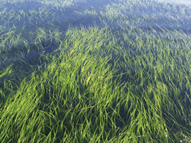Can hard clams (Mercenaria mercenaria) increase the rate of eelgrass (Zostera marina) recovery in areas impacted by oyster aquaculture?
G-14-01-004
Description
Seagrasses such as eelgrass (Zostera marina) have been shown to stabilize the shoreline, reduce water column turbidity and provide nursery grounds and habitat for many invertebrate and fish species. Unfortunately, eelgrass communities are declining in many areas of the world, mainly due to increased inputs of nutrients and sediments from land-based sources. Recent ACRDP research (MG-10-01-001) has revealed that shading from oyster aquaculture structures can also reduce the distribution, photosynthesis and productivity of eelgrass. Moreover, this impact extends beyond the duration of the shading period, with no significant signs of eelgrass recovery for up to 794 days after the removal of the aquaculture structures.
In an attempt to counter the decline in eelgrass habitat, enhancement activities such as manual seed dispersal and transplanting whole plants have been explored, but have found limited success at a substantial cost. Bivalves have been found to stimulate eelgrass growth by clarifying the water column, thereby increasing light availability, as well as increasing nitrogen levels through the production of waste products (faeces, pseudofaeces). This ACRDP project will aim to determine whether the seeding of hard clams (Mercenaria mercenaria) can enhance eelgrass recovery in areas impacted by oyster aquaculture. Various densities of hard clams will be introduced to areas with bare or sparse patches of eelgrass due to shading from previous commercial off-bottom oyster operations. Sediment characteristics, such as porosity (the empty space between sediment particles), organic content and carbon/nitrogen levels will be monitored along with the growth and recovery of the eelgrass over three years. Additionally, clams will be sown directly under lines of suspended oyster bags at an active aquaculture site, to determine if their presence will encourage the growth of eelgrass populations in this heavily-impacted area. The strategies tested in this study may promote the development of environmentally-friendly practices for the aquaculture industry by mitigating the negative impacts of active leases and eliminating the impacts of those sites no longer in use.
This project supports the environmental performance objective of the Aquaculture Collaborative Research and Development Program (ACRDP), and pertains to the 2014-15 national ACRDP priority to examine environmental impacts from aquaculture to the environment by increasing knowledge and understanding of how aquaculture shellfish operations impact the environment, and developing the means to manage, mitigate and control these impacts.
Program Name
Aquaculture Collaborative Research and Development Program (ACRDP)
Year(s)
2014 to 2017
Ecoregion(s)
Atlantic: Gulf of St. Lawrence, St. Lawrence Estuary
Principal Investigator(s)
Monica Boudreau
Email: Monica.Boudreau@dfo-mpo.gc.ca
Collaborative Partner(s)
L'Étang Ruisseau Bar Ltd.
- Date modified:
